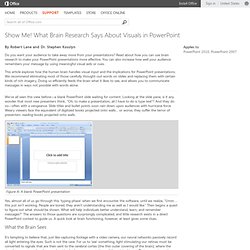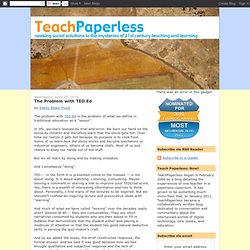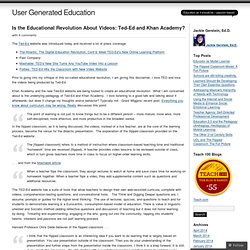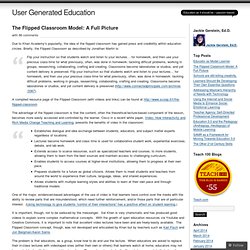

Triptico Plus. Creating Products to Show and Share Learning. My students produced a lot of media, including podcasts.

Before my students scripted and recorded a podcast, they would listen to several sample episodes and critique them. We would make a list of what was really good about the episode and what could be improved. I reminded students of the items on these lists periodically as they worked on their own episodes. Yes, you can tell students what makes a great production. However, having them be the ones to delineate the qualities of a great production is much better.
Multimedia2013 [licensed for non-commercial use only] / Cool tools. Show Me! What Brain Research Says About Visuals in PowerPoint - PowerPoint. By Robert Lane and Dr.

Stephen Kosslyn Do you want your audience to take away more from your presentations? Read about how you can use brain research to make your PowerPoint presentations more effective. You can also increase how well your audience remembers your message by using meaningful visual aids or cues. This article explores how the human brain handles visual input and the implications for PowerPoint presentations.
We’ve all seen this view before—a blank PowerPoint slide waiting for content. Yes, almost all of us go through this ‘typing phase’ when we first encounter the software, until we realize, “Umm … this just isn’t working. What the Brain Sees It’s tempting to believe that, just like capturing footage with a video camera, our neural networks passively record all light entering the eyes. What does all this mean to a presenter? TED-Ed turns ideas into lessons, children into educators. Andy Robertson Chief GeekDad TED-Ed is a new part of the TED family that aims to help turn videos -- such as a YouTube clip -- into classroom-ready lessons with questions, essays and further reading advice.

Numerous features of TED-Ed make the process easy for professional educators and enthusiastic parents. But where it could have been limited to only working with TED talks, it allows any YouTube video to become a TED-Ed lesson. My kids took to the idea immediately -- but not quite how I expected. "Let's make a lesson about how to empty the dishwasher! " The Problem with TED Ed. By Shelly Blake-Plock The problem with TED Ed is the problem of what we define in traditional education as a "lesson".

In life, we learn lessons by trial-and-error. We burn our hand on the stove as children and therefore learn that the stove gets hot. Over time we realize it gets hot because its purpose is to cook food. Some of us learn how the stove works and become mechanics or industrial engineers; others of us become chefs. But we all learn by doing and by making mistakes. And I emphasize "doing". TED -- in the form it is presented online to the masses -- is not about doing.
And much of what we have called "lessons" over the decades really aren't lessons at all -- they are consumables. And so we added the essay, the brief constructed response, the formal answer. None of this led to "learning" for the overwhelming majority of students. Lessons Worth Sharing.
Is the Educational Revolution About Videos: Ted-Ed and Khan Academy? The Ted-Ed website was introduced today and received a lot of press coverage: Prior to going into my critique of this so-called educational revolution, I am giving this disclaimer, I love TED and love the videos being produced by Ted-Ed.

Khan Academy and the new Ted-Ed website are being touted to create an educational revolution. What I am concerned about is the underlying pedagogy of Ted-Ed and Khan Academy. I love listening to a good talk and talking about it afterwards, but does it change my thoughts and/or behavior? Typically not. The point of learning is not just to know things but to be a different person – more mature, more wise, more self-disciplined, more effective, and more productive in the broadest sense. In the flipped classroom, as it is being discussed, the videos, instead of a live teacher, are at the core of the learning process, become the venue for the didactic presentation. Teachers Homepage - National Geographic Education.
This website would like to remind you: Your browser (Firefox 17) is out of date.

Update your browser for more security, comfort and the best experience on this site. Educators! Take our survey for a chance to win a $50 Amazon gift card. Xpeditions is now archived in National Geographic Education's new website—natgeoed.org If you liked Xpeditions, you'll love the new media-rich natgeoed.org. Www.natgeoed.org Please note: to search for Xpeditions content, check the “include archive” filter. National Geographic Education Twitter Facebook Google+ Email. PBS: Public Broadcasting Service. Khan Academy. The Flipped Classroom Model: A Full Picture. Due to Khan Academy’s popularity, the idea of the flipped classroom has gained press and credibility within education circles.

Briefly, the Flipped Classroom as described by Jonathan Martin is: Flip your instruction so that students watch and listen to your lectures… for homework, and then use your precious class-time for what previously, often, was done in homework: tackling difficult problems, working in groups, researching, collaborating, crafting and creating. Classrooms become laboratories or studios, and yet content delivery is preserved.